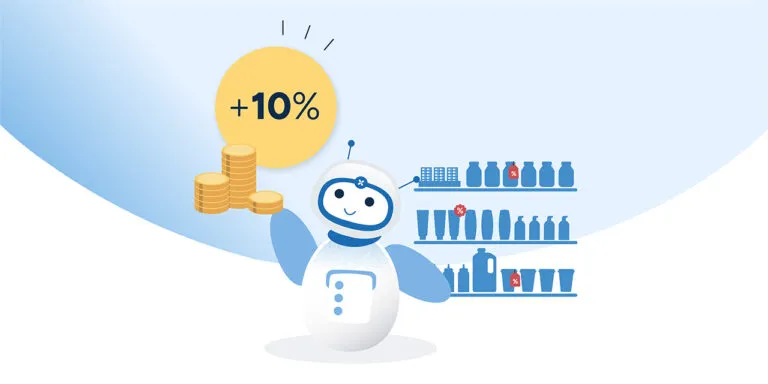Fresh packaged food manufacturers must dream bigger about forecasting
Sep 7, 2023 • 7 min
In a dream world with a flawless supply chain — one where consumer sentiment didn’t shift out of the blue, and material shortages were the stuff of cautionary tales—fresh packaged food manufacturers might entertain such lofty ambitions for their demand forecasts as:
A channel-product-day level forecasting accuracy of 90%. A 15% decrease in internal process waste.
That’s not to say that every fresh packaged food company (also known as a “food to go” company) doesn’t already strive to deliver the freshest goods at the optimal time to their retail customers. But the window for delivering fresh products is dauntingly tight. Even some of the most ambitious companies have accepted a relatively high level of spoilage and waste as the cost of doing business in a volatile market. Per the Food and Agriculture Organization of the United Nations (FAO), as much as 40% of total food production goes to waste before ever reaching the market.
Still: A forecasting accuracy of 90%. A 15% reduction in waste. It can’t hurt to dream, right?

It’s not a dream, though. Both of these figures are actual results achieved by major fresh foods companies that use RELEX to supercharge their demand forecasting. These customers were struggling with the same freshness and waste concerns that plague all fresh packaged food manufacturers, yet they managed to achieve revenue-boosting results.
So how does one make this fresh dream a reality? Spoiler: It involves high-accuracy forecasts, better retail customer collaboration, and a capable supply chain planning platform.
Success in the fresh packaged food supply chain is hard to come by
First, the problem: It’s really hard for many fresh packaged food companies to maximize profitability in the current market. Inefficiency and uncertainty affect every business along the supply chain, but these woes have especially affected companies dealing in fresh foods.
Material shortages
Material shortages force manufacturers to delay production, and logistical and manufacturing snags result in the delivery of products that are past peak freshness. This forces retail customers to sell substandard fresh meals. The customer might also cite quality stipulations in their contracts to reject these products outright, costing the manufacturer a great deal of money.
Demand volatility
Then, there’s the continuing volatility of consumer demand. Customer pricing, competitor promotions, product cannibalization, and even social media trends all affect consumer demand for any type of product. Yet, manufacturers must also factor seemingly innocuous events into their demand forecasts. For example:
- A nearby conference that creates a higher demand for ready-made sandwiches.
- Road construction that impedes foot traffic to the retailer.
- A period of hot weather that drives increased demand for smoothies or similarly refreshing products.
Factors like these can cause consumer demand to shift very quickly and dramatically, potentially skewing the accuracy of forecasts overnight. Such forecasting inaccuracies are unforgiving in the world of fresh packaged food and can contribute to the nearly 20% spoilage rates that RELEX specialists have encountered out in the wild.
Inflation
Inflation also impacts consumer decision-making. People have become incredibly price-conscious in the face of sky-high price increases, and they’ve also become more selective about what products they’ll purchase and what brands they’ll buy from. Many consumers will simply buy the cheapest option if presented with a variety of otherwise similar products.
The tendency for consumers to spend less in these periods of high inflation doesn’t bode well for manufacturers. With spoilage an ever-present threat, retailers already see a reason to offer discounts on fresh packaged food in perpetuity to avoid spoilage. Retailers then seek out better prices and discounts from suppliers who already face thin margins on their offerings because of inflationary pressures on the cost of materials.
The cheapest food, or the freshest?
And now, an admission: Freshness in and of itself will not fix most of the challenges facing fresh packaged food manufacturers. Fresher products can’t prevent material shortages. A crunchier carrot stick won’t stop inclement weather from influencing demand.

Yet freshness does work wonders as a differentiator for consumers. The consumer preference for higher-quality, fresher foods has only grown in recent years, with a whopping 70% of consumers shopping primarily at the store they consider as having the best fresh food. Meanwhile, seven out of 10 consumers will pay more for food they deem to be fresh.
The consumer willingness to pay more for higher-quality fresh products allows manufacturers and their trading partners to suggest an alternative for consumers who might otherwise seek the lowest cost:
How about eating the best food instead?
The key to freshness for packaged food companies: Higher accuracy demand forecasting
Of course, companies need to deliver truly fresh goods to their retail customers before consumers can buy them. Sure, freshness can’t fix material shortages or blunt the impact of weather on demand, but highly accurate demand forecasting can.
Modern digital forecasting platforms use machine learning and reams of data to produce forecasts with the level of accuracy that those still using manual processes can only dream of. The best platforms can even sense demand shifts as they occur and automatically update forecasts accordingly — provided the system has access to a variety of up-to-date data sources, including:
- Internal company data. This includes pricing changes, product intros and terminations, and assortment changes.
- Retail customer data. This includes valuable POS data, promotion plans, and open sales orders.
- External data. This is data that helps the platform factor in competitor actions, local or regional events, and — yes — even the weather.
Short-term forecasts that change with demand fluctuations are essential for fresh packaged food manufacturers looking to deliver only the freshest goods and minimize spoilage, but higher-accuracy forecasting provides another boon for manufacturers as well. Companies can also run longer-term forecasts to better gauge their production planning needs, which helps them avoid costly production issues.
The best platforms can even sense demand shifts as they occur and automatically update forecasts accordingly.
Imagine a fresh packaged food company’s longer-term forecast identified a need for more iceberg lettuce over the warm-weather months. However, the company’s usual lettuce producer had a poor harvest and couldn’t provide the additional product volume. The longer-term forecast affords the manufacturer more lead time in finding an alternative producer, allowing them to potentially avoid a material shortage altogether.
A fresh approach to customer collaboration — with help from RELEX
The level of demand forecasting accuracy needed to ensure freshness, reduce waste, and improve profitability can’t be conjured out of thin air. Better demand forecasts are built from many parts, including a capable team of planners and reams of internal data.
But internal data simply isn’t enough. Manufacturers need essential data from their retail customers and trading partners to achieve truly remarkable demand forecasting capabilities.
Most suppliers don’t get as much relevant data from their wholesale and retail partners as they’d prefer, and only 47% of suppliers collaborate weekly with their trading partners. Yet close collaboration with retail customers and other trading partners is the cornerstone of supply chain success. Free-flowing data on promotional plans and assortment changes provides essential insight into major demand factors for manufacturers, wholesalers, and retailers alike. And manufacturers especially need valuable point-of-sale (POS) data from retailers to properly sense demand fluctuations.
Occasionally, a company will highlight two sticking points regarding collaboration: it’s frequently time-consuming and often overly complicated. But the market is full of supply chain planning platforms that facilitate simpler, better data-sharing between suppliers and their customers. There are also digital solutions with the machine-learning and demand sensing capabilities required for highly accurate demand forecasting, including some that can be configured and tailored to meet a company’s unique pain points and needs.
Science, magic, and fresh forecasting success
Writer Arthur C. Clarke famously noted, “Any sufficiently advanced technology is indistinguishable from magic.”
Now, think back to those seemingly fantastical statistics that brought us here. Companies using manual forecasting might not believe those results to be achievable, especially for fresh packaged food.
But let’s look at them again — this time through the lens of high-accuracy demand forecasting.
“A channel-product-day level forecasting accuracy of 90%.”
This number is incredible on its own, but it is even more so with further context. This RELEX customer runs constant promotions on their products, adding a further wrinkle of complication to the forecasting process. They’ve also used the RELEX forecasting capabilities to improve their two-week forecasts, greatly aiding their production planning. This increased accuracy has paid off in increased profitability and decreased waste.
Speaking of decreased waste, here’s the other statistic:
“A 15% decrease in internal process waste.”
Such a major reduction in waste is applaudable, but it is especially impressive considering that this result stems from a different RELEX customer that produces and manages thousands of SKUs. They also embraced the automated aspect of RELEX forecasting, which helped them reduce manual forecasting adjustments by 13%.
Whether or not these companies believed such numbers were achievable before tackling their accuracy and spoilage goals is moot. They can afford to dream bigger now that they’ve achieved such lofty results.
And for those who still find such results hard to believe, we promise it’s not magic. But it is RELEX.



